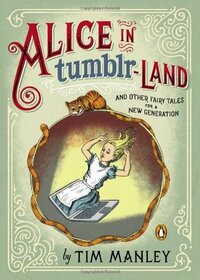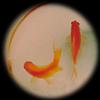Take a photo of a barcode or cover
A cute fast read for twenty and thirty something's who will appreciate the combination of fairy tales with contemporary problems
Fairy tales retold for the 20-something set. Made me laugh out loud a few times.
Tim Manley’s Alice in Tumblr-land: And Other Fairy Tales for a New Generation tells the stories of fairy tale princesses and heroes, as twenty-somethings navigating relationships, friends, sex, careers and social media.
The Tortoise and the Hare Facebook-stalk each other down opposite career paths. Robin Hood worries if his killer social media campaign is fighting hunger or just slacktivism. Beauty’s new boyfriend plays videogames in his underpants. Ariel just doesn’t get pop culture, besides the episode of Hoarders with all the forks. Rapunzel posts a selfie with her short new do, and wonders, did everyone hate my old look without telling me? Ping’s father still calls him “Mulan” sometimes, but he calls the internet “AOL”, so Ping tries not to hold it against him.
Each story is told in a short blurb -- a bit longer that a tweet, shorter than my blog posts -- and then on to the next story, with the major narratives picked up again. The result is a magical Tumblr feed of fairy-tale characters living out their twenty-something adventures.
Read the rest (mild spoilers, I guess?)
The Tortoise and the Hare Facebook-stalk each other down opposite career paths. Robin Hood worries if his killer social media campaign is fighting hunger or just slacktivism. Beauty’s new boyfriend plays videogames in his underpants. Ariel just doesn’t get pop culture, besides the episode of Hoarders with all the forks. Rapunzel posts a selfie with her short new do, and wonders, did everyone hate my old look without telling me? Ping’s father still calls him “Mulan” sometimes, but he calls the internet “AOL”, so Ping tries not to hold it against him.
Each story is told in a short blurb -- a bit longer that a tweet, shorter than my blog posts -- and then on to the next story, with the major narratives picked up again. The result is a magical Tumblr feed of fairy-tale characters living out their twenty-something adventures.
Read the rest (mild spoilers, I guess?)
Do you like the Fairy Tales for 20 Somethings Tumblr? Well...then you've pretty much read this book. This is extended stories of our favorite fairy tale characters as they hit the quarter life crisis. What happens when Prince Charming tells Snow White he's ready to have a baby? Will Cinderella be able to make it as a photographer? Will Peter Pan EVER grow up? All these questions (and more) are answered. This was amusing, especially for reluctant readers or just as a book for an upcoming trip (so perfect for that flight home for the holidays).
Hilarious and sweet, and a perfect gift for that friend you made online who is super awesome. Or for that friend that moved far away, and now you only keep in contact though the web.
Just perfect, really though.
Ten out of ten, would buy again.
Just perfect, really though.
Ten out of ten, would buy again.
Fairy tales for the modern generation, the Millennials who go nuts with social networking, get embroiled in discussions of gender politics, and who understand that angst over whether someone really likes the thing they Like on Facebook is a thing. Welcome to Alice in Tumblr-Land.
The book features some modern retellings of fairy tales, and I’m not sure if it the fact that all the fairy tale characters (and the associated illustrations) were drawn from Disney’s adaptations of fairy tales was meant to be a tongue-in-cheek attempt at humour or an honest misunderstanding that, for example, the little mermaid wasn’t actually named Ariel in the original story, and that Mulan isn’t technically a fairy tale as we think of them.
The stories are told in short quick bursts, an appeal to the sound-bite generation, constantly jumping from story to story like someone changing TV channels. Break off one story, jump to another, rinse and repeat. This allowed for more of the humour to come through and kept everything quick and punchy, but it meant that the reader is holding over a dozen simultaneous plots in their mind all at once, and can’t just follow one particular story without having the others in the way.
This is a book to chuckle at, to read quickly and then put aside knowing that it enriched your life for the time you were reading it but that was all. Possibly another commentary on the Millennial generation; everything must be sleek and quick and gone almost as soon as it arrived. You roll your eyes at Peter Pan’s Internet addiction, you laugh at Pinocchio’s promises (the Pinocchio stories are usually a single sentence telling a classic lie, and that’s all there needs to be), you nod your head at Mulan’s gender transition and Robin Hood’s social activism, you root for Arthur’s crush on Lancelot, and you wince at the painfully accurate political commentary of the Three Little Pigs. For those who don’t know any world but this one, for those who live in this moment and no other, these are the fairy tales for the new generation, the messages the same as they ever were even in the stories’ new forms. The audience appeal may be pretty limited and the entertainment may be transient, but it’s a quick read and worth the chuckles it gives.
(Book received in exchange for an honest review.)
The book features some modern retellings of fairy tales, and I’m not sure if it the fact that all the fairy tale characters (and the associated illustrations) were drawn from Disney’s adaptations of fairy tales was meant to be a tongue-in-cheek attempt at humour or an honest misunderstanding that, for example, the little mermaid wasn’t actually named Ariel in the original story, and that Mulan isn’t technically a fairy tale as we think of them.
The stories are told in short quick bursts, an appeal to the sound-bite generation, constantly jumping from story to story like someone changing TV channels. Break off one story, jump to another, rinse and repeat. This allowed for more of the humour to come through and kept everything quick and punchy, but it meant that the reader is holding over a dozen simultaneous plots in their mind all at once, and can’t just follow one particular story without having the others in the way.
This is a book to chuckle at, to read quickly and then put aside knowing that it enriched your life for the time you were reading it but that was all. Possibly another commentary on the Millennial generation; everything must be sleek and quick and gone almost as soon as it arrived. You roll your eyes at Peter Pan’s Internet addiction, you laugh at Pinocchio’s promises (the Pinocchio stories are usually a single sentence telling a classic lie, and that’s all there needs to be), you nod your head at Mulan’s gender transition and Robin Hood’s social activism, you root for Arthur’s crush on Lancelot, and you wince at the painfully accurate political commentary of the Three Little Pigs. For those who don’t know any world but this one, for those who live in this moment and no other, these are the fairy tales for the new generation, the messages the same as they ever were even in the stories’ new forms. The audience appeal may be pretty limited and the entertainment may be transient, but it’s a quick read and worth the chuckles it gives.
(Book received in exchange for an honest review.)


